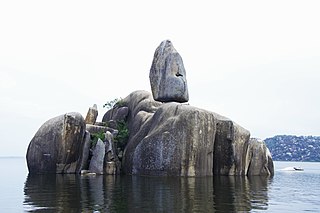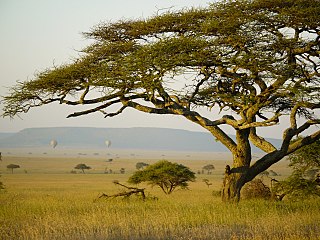
Kagera Region is one of Tanzania's 31 administrative regions. The region covers an area of 35,686 km2 (13,778 sq mi). The region is comparable in size to the land area of the Netherlands. Kagera Region is bordered to the east by Lake Victoria, Mwanza Region and Mara Region. The region is bordered to the south by Geita Region and Kigoma Region. Lastly, Kagera borders Rwanda to the west, Uganda to the north and Burundi to the south west. The regional capital city is Bukoba. According to the 2022 national census, the region had a population of 2,989,299, an increase from 2,458,023 recorded in 2012.

The Suba (Abasuba) are a heterogeneous Bantu group of people in Kenya with an amalgamation of clans drawn from their main tribes Ganda people, Luhya people, and Soga who speak the Suba language that is closely similar to the Ganda language spare some lexical items borrowed from [[Luo. Their population is estimated at 157,787, with substantial fluent speakers. They migrated to Kenya from Uganda and settled on the two Lake Victoria islands of Rusinga and Mfangano, others also settled on the mainland areas including Gembe, Gwassi, Kaksingri of Suba South and Migori and are believed to be the last tribe to have settled in Kenya. The immigrants to present-day Subaland trace their ancestry among Ganda people, Luhya people, Soga people, and the Luo people. The evidence supporting this is the fact that some Suba groups speak languages similar to Luganda, Lusoga and the Luhya. The Suba groups tracing ancestry among the Kenyan tribes preceded those groups from Uganda in present-day Subaland and are the numerous and influential ones. Those groups from Uganda are mostly concentrated in Rusinga and Mfangano islands with small pockets of them being found in mainland Kenya. Linguistically, the Suba are highly influenced by the neighbouring Luo, to the point of a language shift having taken place among large portions of the mainland Suba. As a result, their own language has been classified as endangered. Despite this language shift, the Suba have kept a distinct ethnic identity. The Rusinga Festival is held in December of every year as a cultural festival to celebrate and preserve Suba culture and language.

Mwanza City, also known as Rock City to the residents, is a port city and capital of Mwanza Region on the southern shore of Lake Victoria in north-western Tanzania. With an urban population of 1,311,000 in 2023, it is Tanzania's second largest city, after Dar es Salaam. It is also the second largest city in the Lake Victoria basin after Kampala, Uganda and ahead of Kisumu, Kenya at least in population size. Within the East African community, Mwanza city is the fifth largest city after Dar, Nairobi, Mombasa, and Kampala. It is slightly ahead of Kigali, Kisumu, and Bujumbura in the population of city proper limits. Mwanza city is also the capital city of Mwanza Region, and is administratively divided into two municipal districts within that Region - Ilemela and Nyamagana.

Mara Region is one of Tanzania's 31 administrative regions. The region covers an area of 21,760 km2 (8,400 sq mi). The region is comparable in size to the combined land area of the nation state of El Salvador. The neighboring regions are Mwanza Region and Simiyu Region, Arusha Region, and Kagera Region. The Mara Region borders Kenya .The regional capital is the municipality of Musoma. Mara Region is known for being the home of Serengeti National Park, a UNESCO World Heritage site and also the birth place of Tanzania's founding father Julius Nyerere. Under British colonial occupation, the Mara Region was a district called the Lake Province, which became the Lake Region after independence in 1961.

Musoma is a city in the east shore of Lake Victoria of Tanzania. It is the capital of Mara Region, one of the administrative Regions of Tanzania. It also serves as the administrative centre of Musoma Rural District and Musoma Urban District.

Ukerewe District is one of the seven districts of the Mwanza Region of Tanzania. It is located on Ukerewe Island, Ukara Island and other neighbouring islands within Lake Victoria. The largest settlement and the district's administrative capital is Nansio.

Mwanza Region is one of Tanzania's 31 administrative regions. The region covers a land area of 25,233 km2 (9,743 sq mi). The region is comparable in size to the combined land area of the nation state of North Macedonia. Mwanza Region is bordered to the north through Lake Victoria by the Kagera Region and Mara Region, to the east by Simiyu Region, to the south by the Shinyanga Region and to the west by Geita Region. The regional capital is the city of Mwanza. According to the 2022 national census, the region had a population of 3,699,872 and national census of 2012 had 2,772,509. Mwanza Region is the second region with high population in Tanzania after Dar es Salaam Region.

Tabora Urban is one of the seven districts in the Tabora Region of Tanzania. This district is mostly the city of Tabora and its suburbs. It is bordered almost completely by the Uyui District. It has a small border with Nzega District to the north. Its administrative seat is the city of Tabora.

Tarime District is one of the seven districts of the Mara Region of Tanzania, East Africa. It was previously known as the "North Mara District". Its district capital is Tarime town. It is bordered from the north to east by the Kenyan districts of Migori, Trans Mara and Kuria East and West Districts, and to the east by the Maasai Mara game reserve. To the south it is bordered across the Mara River by the Serengeti and Butiama districts, and to the west by Rorya District.

Musoma Rural District is one of the 9 districts of Mara Region of Tanzania. Mara region has the following Districts councils: Musoma district council, Rorya district council, Tarime rural, Tarime town council, Butiama, Serengeti, Bunda rural council, Bunda town Council and Musomal Municipal council. Its administrative centre is the town of Musoma. The district is bordered to the east by Butiama District, to the south by Bunda District and to the west and north by Lake Victoria.
The Suba of Tanzania are a community of people in Rorya District, Mara Region, Tanzania speaking mutually intelligible varieties of the Suba language. They are mainly located in Nyancha, Luo-Imbo and Suba Divisions of Rorya District. The groups commonly listed as being part of the Suba community are the Hacha, Kine, Rieri, Simbiti, Surwa and Sweta. There are a total of around 80,000 ethnic Suba living in Tanzania, most of whom are still speaking the Suba language although some, particularly the Rieri, have started to speak Luo.
The Anglican Church of Tanzania is a province of the Anglican Communion based in Dodoma. It consists of 28 dioceses headed by their respective bishops. It seceded from the Province of East Africa in 1970, which it shared with Kenya. The current primate and archbishop is Maimbo Mndolwa, enthroned on 20 May 2018.

The Kuria people (also known as the AbaKurya, are a Bantu community in Tarime District of Mara Region in Tanzania and southern Kenya. Their homeland is bounded on the east by the Migori River and on the west by the Mara River estuary. Traditionally a pastoral and farming community, the Kuria grow maize, beans and cassava as food crops and coffee and maize as cash crops.
Shirati is a town in Rorya District in North Mara, Tanzania on the shore above Lake Victoria, near the border with Kenya. It has a population of c. 100,000 It is the northernmost town at the border with Kenya at is located in Royra District. Most of the residents of Shirati are DhoLuo speaking people Nilotes. Suba people, a subbranch of Bantu communities who adopted Luo customs, language, and practices also live in Shirati. Similarly, Shirati has a substantial number of Westerners who work at the mission at Kabwana – translated into "the white people's home" from Luo.

Migori County is a county in the former Nyanza Province of southwestern Kenya. It borders Homa Bay County to the north, Kisii County to the northeast, Narok County to the southeast, Tanzania to the west and south, and Lake Victoria to the west. The county also borders Uganda via Migingo Island in Lake Victoria. The county is headquartered by Migori, which is also its largest town. At the 2019 census, Migori County had a population of 1,116,436, almost 200,000 more than the 917,170 recorded in 2009.

Simiyu Region is one of Tanzania's 31 administrative regions. The region covers a land area of 25,212 km2 (9,734 sq mi). The region is comparable in size to the combined land area of the nation state of North Macedonia. The region is bordered to the north by the Mara Region, to the south by the Shinyanga Region and Singida Region. Mwanza Region borders the region to the west through Lake Victoria, and Arusha Region to the east. The region is home to the Serengeti National Park, a UNESCO World Heritage Site, shared with Mara Region. The regional capital is the town of Bariadi. According to the 2022 national census, the region had a population of 2,140,497.
Kemambo is a ward in Tarime District, Mara Region of northern Tanzania, East Africa. In 2016 the Tanzania National Bureau of Statistics report there were 14,718 people in the ward, from 13,338 in 2012.
Matongo (Tarime) is a ward in the Tarime District of the Mara Region of Tanzania, East Africa. In 2016 the Tanzania National Bureau of Statistics report there were 21,160 people in the ward, from 19,176 in 2012.
Mwema(Tarime) is a ward in Tarime District, Mara Region of northern Tanzania, East Africa. In 2016 the Tanzania National Bureau of Statistics report there were 11,260 people in the ward, from 10,204 in 2012.

Isaya Mwita Charles is a Tanzanian politician who has been serving as the 17th and current Mayor of Dar es Salaam since March 21, 2016. Prior to his appointment as mayor, he served at the Temeke Municipal Council as a cashier before contesting the general election for the Vijibweni Ward representative as councilor at Kigamboni District in Dar es Salaam.














